WHILE CONTEMPORARY READERS OF AUSTEN’S NOVELS would have understood her references to wilderness gardens, this understanding is not shared by modern readers, partly because very few examples of this genre now survive, and partly because they have received relatively little consideration in garden history. As my own interest in this topic has developed across the last thirty years, I have become aware that even the owners of onetime wilderness gardens have little knowledge of the history of the genre.1 In this essay I therefore seek to provide an overview of the history of the wilderness garden (sections 1-3), some suggestions about two gardens that Austen may have used as models for the Sotherton episode in Mansfield Park (section 4), and finally some suggestions about how we should read that episode once we have begun to understand what a “wilderness garden” implied in Austen’s time (section 6). Almost incidentally, since some shrubberies evolved from wilderness gardens, it seems economic to sketch the history of shrubberies en route (section 5). Readers who are primarily interested in literary aspects might want to read section 6 first, and then, if they want to explore the rather rich history, go back to sections 1-4.
1. Eighteenth-century English wilderness gardens
In part the erasure of wilderness gardens from our cultural history derives from the way in which the open landscaping practices of Capability Brown (active 1750-1783) and his successors, notably Humphry Repton (active 1787-1811), destroyed most existing wilderness gardens and ideologically associated English gardening with the idea of an empty, rolling grassland ornamented with clumps of trees and natural-looking ponds. This transformation, however, was neither universal nor instantaneous, and in Austen’s lifetime many of her readers would have been more familiar and comfortable with the formal style of gardening evident at Chatsworth (c. 1699) than with the parkland view seen in the later painting of Chatsworth by William Marlow (c. 1770).
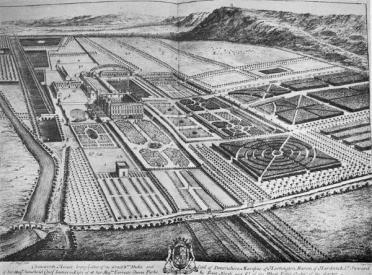
Chatsworth in 1699 from Britannia Illustra. |
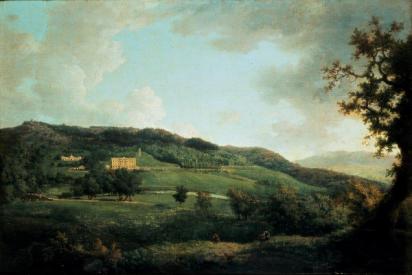
Chatsworth, by William Marlow (1770). |
Marlow’s view is very much of the kind that inspires Elizabeth Bennet from the windows of Pemberley. In Mansfield Park, probably set in 1805 (Fleishman), tensions between the earlier, formal styles of gardening and the Reptonian vogue are still urgently felt: Sotherton is an Elizabethan house with late-seventeenth-century additions and a wilderness garden typical of the period 1700-1730, and Mr. Rushworth’s vague schemes for getting Repton in to improve it, echoed in Henry Crawford’s Reptonian plans for the improvement of Thornton Lacey, are represented as violently destructive of customary, venerable order. Fanny Price’s veneration for the avenues at Sotherton, another feature typical of the late seventeenth century, is often taken to imply where Austen’s own sympathies lay.
The fashion for laying out wildernesses within the pleasure grounds of large estates was prevalent in the years 1690-1750, probably peaking around 1735-1740. There was a small wilderness at Chawton House, laid out sometime between the late seventeenth century and the 1740s, vestiges of which remain to this day (Dix and Yates 1). There were larger wildernesses at two other Kentish houses Austen almost certainly knew through family connections around Sevenoaks, Knole, and Chevening, and, as I will explore in detail in section 4, there was a very large wilderness garden owned by Baron Bolton, a family friend of the Austens, at Hackwood near Steventon. Such wildernesses were woodland areas divided into “quarters”2 by regular avenues (allées), which were graveled or turfed and hedged with clipped hornbeam or beech, perhaps to a height between 8 and 18 feet. The spaces inside the quarters were usually planted with shrubs and trees, either in orderly rows or in a natural disposition, but they sometimes included grassed, open spaces. The basic layout of avenues was formal, taking its inspiration from the Italian and French parterre of the sixteenth and seventeenth centuries.
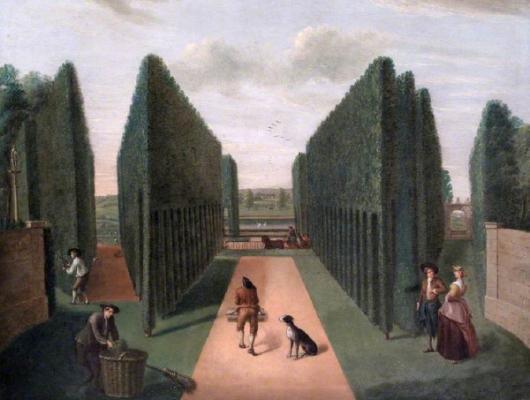
The goose foot at Hartwell House, by Balthazar Nebot (1733).
Often the major avenues were in the form of a goose foot (patte d’oie) radiating out from the front of the house, as in the gardens at Hartwell House (c. 1720), and at Chiswick laid out by Lord Burlington, 1715-1730, with the assistance of William Kent and advice from Alexander Pope. Where parterre planting is low, wilderness planting is intentionally high, so that the visitor’s gaze is directed along the avenues, sometimes towards a distant eye-catcher.
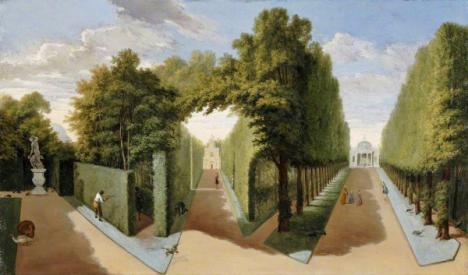
Chiswick House goose foot, by Pieter Andreas Rysbrack (1729-1731). |
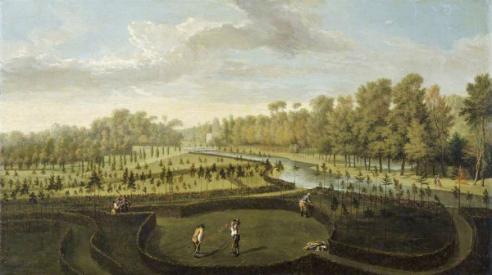
Chiswick House garden from west towards bagnio, |
In 1704 Timothy Nourse describes an ideal country seat, with a kitchen garden and three pleasure gardens. The first two pleasure gardens are versions of parterres; the third is “wholly to be designed as a Boscage” structured around three long alleys, with the adornment of “private alleys or walks of beech, for this is a delicate green” (321). This woodland garden should be planted with cypress, firs, laurels, philyreas, bays, tamarisk, the silac tree, pyracantha, yew, juniper, holly, cork trees, and with “all sorts of winter greens,” plus wild vines, bean trefoil, Spanish ash, horse chestnut, sweet briar, honeysuckle, roses, almonds, and mulberries. As in other eighteenth-century descriptions of the wilderness, Nourse seems to let his imagination run riot, listing all manner of species that would get quickly out of control and create insuperable maintenance problems. But then, one might ask, what else is a wilderness? One of the governing objects of a wilderness is to appear “Natural-Artificial; that is, let all things be dispos’d with that cunning, as to deceive us into a belief of a real Wilderness or Thicket, and yet to be furnished with all the Varieties of Nature.”
Such wildernesses, however, must be kept within formal bounds, as if a token of wilder nature beyond the pleasure grounds (thus echoed by the aviaries they often contained):
And at the upper end of this Wilderness, let there be a Grate-Gate, answering the Entrance to the Garden; beyond which, and without the Territory of our Garden, let there be planted Walks of Trees to adorn the Landskip; Likewise a Bowling-Green and Paddock would be suitable to this higher Ground; and thus at length the Prospect may terminate on Mountains, Woods, or such Views as the Situation will admit of. (322)
The trees planted in each quarter may be in rows, or planted randomly, to give a natural appearance. At Chevening, for example, we find, on either side of a long central basin or miroir d’eau, two elaborate wildernesses within which the planting is still highly regularized.
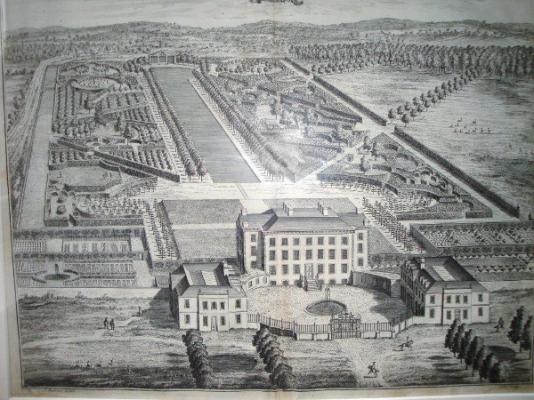
Chevening, by Thomas Badeslade, History of Kent (1719).
This layout is derived from one used by Le Nôtre at Marly in France, and later echoed by one of his followers at Killruddery in Ireland. In other gardens, while the avenues remain regular, the planting in the quarters between them is mixed and naturalistic, and in these cases garden books of the period often recommend that such planting be graduated in height. In 1706, George London and Henry Wise propose
a Plot of Ground, more or less, as you think fit, enclos’d in Palisades of Horn-beam, the Middle of it fill’d with tall Trees, as Elms or the like, the Tops of which make the Tuft or Plume. At the Foot of these Elms, which should grow along the Palisades at equal Distances, other little wild Trees should be planted, and the Tuft that will by this means be formed in the Inside, will resemble that of a Copse. (744).
Similarly, six years later, John James distinguishes woodland areas, which have “not fine Hedges, nor rolled Walks in them, [but] only Ridings cut for Hunting,” from bosquets, which he describes as “Woods of middle Height, . . . which are made use of in fine Gardens, and are truly Groves of Delight and Delicacy” and which are “adorned with Halls, Cabinets, Galleries, Fountains, &c. . . . [and are] bordered with Hedges and Lattice-work, and their Alleys are handsomely kept and well gravel’d, which renders them very neat and curious” (64, 65).
The inspiration for these wilderness gardens originated from the Italian bosco, often mediated by the French bosquet or boscage, notably at Versailles. All these terms meant initially a natural grove or group of trees, and then developed into a name for such a group planted for aesthetic effect. Typically the trees would be tall and distinguished, therefore lime, elm, or chestnut, but sometimes oak. Bosquet then came to name the space created between and within the trees, as in the Bosquet du théâtre d’eau and Bosquet des trois fontaines at Versailles.
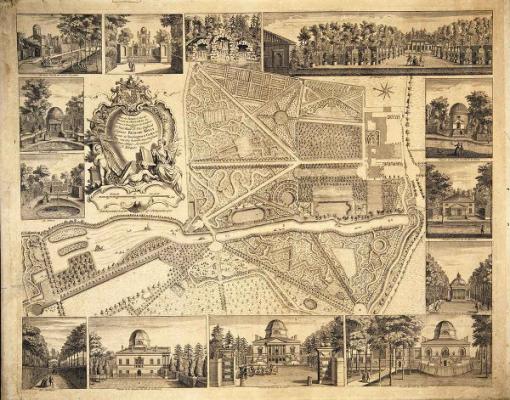
Chiswick House, plan of the grounds, engraved by John Rocue (1736).
As can be seen clearly from contemporary illustrations, these bosquets were usually arranged as blocks within a regular pattern of allées, but, as formal gardening evolved, the strict linearity of the major allées was sometimes supplemented by serpentine paths (notably promoted by Batty Langley, Stephen Switzer, and William Kent, famously with his rill at Rousham) leading to various garden rooms (cabinets, salles vertes, salles de verdures) in which statuary, basins, fountains, and seats would encourage pleasure, meditation, or conversation, and of course appreciation for the taste and discernment of the garden owner. Within such increasingly complex layouts, visitors might become “bewildered” as to where they were, as happens to Mary Crawford in Mansfield Park. Some of this sense of getting lost is evident in the following description from the 1734 edition of Philip Miller’s important compendium The Gardener’s and Florist’s Dictionary:
Wildernesses, if rightly situated, artfully contrived, and judiciously planted, are the greatest Ornaments to a fine Garden. . . . The usual Method of contriving Wildernesses is, to divide the whole Compass of Ground, either into Squares, Angles, Circles, or other Figures . . . [T]he Walks are commonly made to intersect each other in Angles, which also shews too formal and trite for such Plantations, and are by no means comparable to such Walks as have the Appearance of Meanders or Labyrinths, where the Eye can’t discover more than twenty or thirty Yards in Length; and the more these Walks are turned, the greater Pleasure they will afford. These should now and then lead into an open circular Piece of Grass; in the Center of which may be placed either an Obelisk, Statue, or Fountain; and if in the Middle Part of the Wilderness there be contrived a large Opening, in the Center of which may be erected a Dome or Banqueting House, surrounded with a green Plot of Grass, it will be a considerable Addition to the Beauty of the Place. (n.p.)
That the first edition of Miller’s Dictionary in 1724 makes no mention of wildernesses, but the 1734 edition, now much expanded into three volumes, offers two descriptions, one in volume 2 and another in volume 3 (from which this description comes), shows how the importance of wildernesses had increased very much in a decade. Indeed, many such guides consider the addition of a wilderness to be a “must have” garden feature for any nobleman who wishes to be considered as a man of taste.
2. Earlier English and Irish wilderness gardens
In an early and influential history of the genre, Christopher Hussey observes that wildernesses first appear in the gardens by Le Nôtre and by Mansart at Marly, where bosquets flanked a formal water garden and “salles vertes containing lesser pools were linked by shady walks” (61). Hussey suggests that the genre may then have been brought to England by Coke, who visited Marly in 1696-1697, or by George London, who visited in 1698 (Hussey 61; also Jacques and van der Horst 159). However, while Hussey reflects sources published in the early eighteenth-century, his history of the transmission from France now seems too late, since the elements of the style he is describing are evident at Versailles from 1661 (Lablaude 80) and imported by Monsieur Bonet, a Huguenot pupil of Le Nôtre, to Killruddery in County Wicklow, Ireland, in the 1680s (Longville).
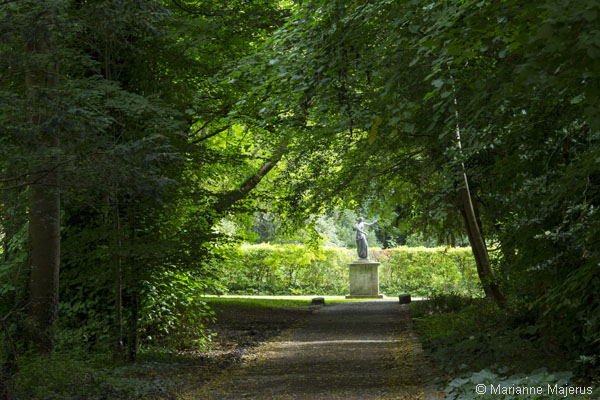
Killruddery, main avenue through the wilderness.
The Killruddery garden is known today as “The Angles,” a term used by John James in 1712 and by Philip Miller in 1734 to describe this kind of garden. On the opposite side of the pair of canals there is a garden known as “the wilderness,” which was originally planted with rows of limes at intervals of about 20 feet, a method evident in the images at Chevening (pictured earlier). These limes have since grown to a splendid height, with an understory of brush developed beneath them.
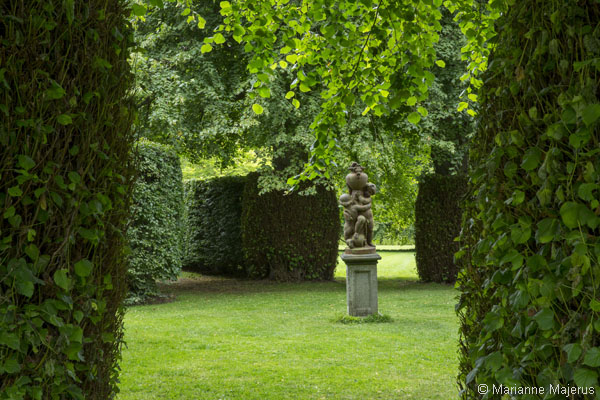
Killruddery, “The Angles.”
The history of Killruddery puts in question Hussey’s account of the transmission of this form of garden to Britain around 1695, as does the fact that there were gardens called “wildernesses” in England from well before the development of Versailles. Indeed, what seems to have occurred is that when the French boscage came to England, it reinvigorated and transformed an earlier “wilderness” tradition; this transplantation is how the idea of “wildness” came to sit so contradictorily upon such artificial and formal designs.
The first “wilderness garden” in England that we are currently able to trace was set out at the Tudor palace of Nonsuch around 1542-1543 by Lord Lumley, a garden lover inspired by the bosci he had seen on his travels in Italy (Biddle 164). Nonsuch had belonged to Henry VIII and was later used by Queen Elizabeth as a retiring seat. In 1599 it was described by the German traveler Thomas Platter as having a wilderness garden comprising a densely planted wood, cut through with “fine straight long alleys of some eighteen to twenty feet to create splendid vistas and shady places for amusement” (Platter 197). According to another contemporary, Bishop Watson of Cheam, the wilderness was planted with a great variety of trees and shrubs: oak, walnut, ash, elms, planes, sycamore, fig, juniper, yew, elder, box, hazel, maple, and olive, as well as ferns and vines, berberis, briars, thorns, and dog rose, and fruit-bearing plants such as apples, pears, cherries, blackberries, and strawberries (Watson, tr. Biddle ).
One hundred years later there is a record of another Royal wilderness, at Wimbledon Palace. It may have been as old as Nonsuch, or more recently constructed: the manor was given by Henry VIII to Thomas Cromwell in 1536, returned to Henry on Cromwell’s death in 1540, sold off, and then repurchased by Charles I. By 1649, the garden certainly included a wilderness:
(a work of vast expence to the maker thereof) [which] consists of many young trees, woods, and sprayes of a good growth and height, cut out and formed into severall ovals, squares, and angles, very well ordered, in most of the angular points thereof, as allsoe in the center of every oval, stands a lyme tree or elme; all the allies of this wilderness, being in number eighteen, are of gravelled earth, very well ordered and maynteyned. (qtd. in Coffin 72)
David Coffin observes that such wildernesses are mentioned in the letters of Lady Anne Clifford (1617), Burton’s Anatomy of Melancholy (1621), and Mary Rich’s diary for the 1660s and 1670s. In the 1650s Elizabeth Dysart also established the famous wilderness garden at Ham House, which the National Trust is now restoring, and John Dryden refers to wildernesses in his 1668 play Evening’s Love: “Disperse your selves, some into the Wilderness, some into the Allyes, and some into the Parterre” (Act 5, Sc. 1).
The most elaborate and famous sixteenth-century garden to contain a wilderness was at Wilton House, Wiltshire, laid out by Isaac de Caus for the Earl of Pembroke (1632-1635). Nearest the house this garden comprised four “embroidered plats” of clipped box, each with a fountain at the center and cypress trees at the corners. To the left and right of these parterres were ornamental flower beds.
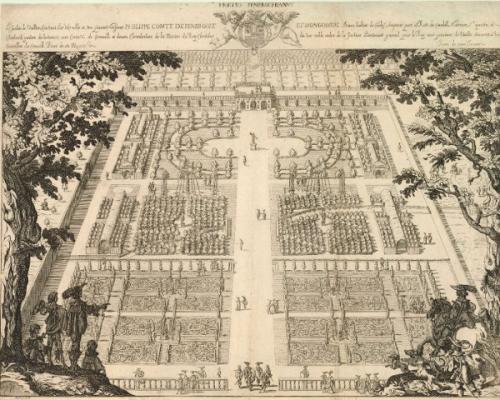
Wilton House, by Isaac de Caus (1645).
The wilderness is the section seen beyond these plats in de Caus’s engraving. It was divided into two equal quarters by the main avenue and inconveniently cut laterally by the curving River Nadder. Each quarter of the wilderness was planted as a regular grove of trees with a statue at its heart, Flora on the one hand, Bacchus on the other. Beyond the wilderness lay two small transverse basins with fountains, and beyond these again lay an oval circus, its walks lined with ornamental cherry trees. The outer edge of the garden was marked on each side by a raised terrace and on the furthest edge by a raised balustraded walkway with an elaborate Italianate portico and viewing platform at its center (Strong 147-61; Hunt 139-42). (As we will see, raised walkways are a recurrent feature of this kind of garden, making an appearance in Austen’s representation of Sotherton, where the visitors have to descend from a terrace in order to enter the garden.)
These examples indicate that in the seventeenth-century a wilderness could either be a relatively formal grove, or a woodland walk where one could walk, meditate, and experience solitariness in a protected, untilled nature, or indeed something very much more formal, as at Wilton. Where the wilderness provided a woodland walk, it called to mind Christ’s wandering in the wilderness to understand his relation to God, and also Adam and Eve’s banishment from Eden (Coffin 85). As an Anglican, Austen would almost certainly have had these religious understandings in mind when she represented the Sotherton wilderness in Mansfield Park, and it is highly probable she had first-hand knowledge of such Renaissance wildernesses from the one set out in the 1570s at Knole, the home of the Sackvilles, earls of Dorset, for whom George Austen’s uncle Francis did much legal and political work. In Austen’s lifetime the Knole wilderness may have still been a woodland navigated by a number of serpentine paths as it appears in Harris’s 1719 History of Kent.3

Knole prospect from the west showing changes made by Ackers,from The History of Kent (1719).
Similarly, Chevening House, near Sevenoaks, a possible source for Rosings in Pride and Prejudice, had a beautiful formal wilderness divided into blocks by a complex pattern of allées and laid out on either side of a central miroir d’eau, probably around 1700 (see earlier image).4 This arrangement of a miroir d’eau flanked by bosquets seems directly derived from Le Nôtre’s work at Marly, as mentioned above, and is also found in the paired canals dividing the pleasure grounds at Killruddery.
Other famous wildernesses laid out around the end of the seventeenth century include Hampton Court, where the gardens were laid out by Wren from 1689 and included a formal wilderness on a St. Andrew’s Cross pattern, with serpentine paths meandering between the dominant diagonals, a central opening dominated by a tall pine, and a number of garden rooms and mazes dispersed in the quarters (Jacques and Arend pl. 19).

Hampton Court, by Johannes Knyff, Britannia Illustrata (1708). On the right, the wilderness is the dense mass of trees cut through with avenues.
Around 1672-1673 a wilderness was laid out at Badminton (Knyff and Kip), and about twenty years later others are laid out at Ham House (1694) and Castle Bromwich Hall (1698). Castle Howard follows in 1706 (Switzer’s revised ancient woodland garden, with serpentine paths and cabinets). Early in the eighteenth century notable wildernesses are laid out at Cirencester Park (by Switzer, after 1713), Melbourne Hall in Derbyshire (c. 1720), and Rest (Wrest) Park in Bedfordshire for Henry Grey, first Duke of Kent, on grounds initially laid out by London and Wise between 1706 and 1720 and into which winding paths were introduced by Batty Langley in the 1730s.
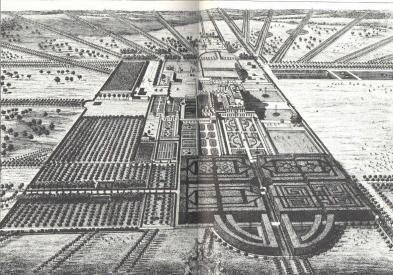
Badminton, by Johannes Knyff, Brittania Illustrata (1707). |
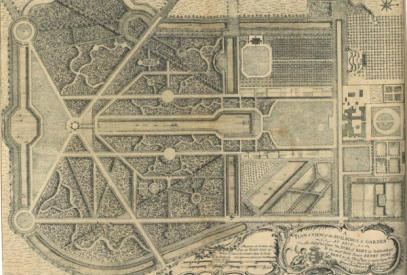
Wrest Park, John Rocque’s plan showing Battey Langley’s |
3. An extant English wilderness garden: St. Paul’s Walden Bury
In the same decade of the 1730s William Kent was working on wildernesses at Chiswick and Rousham, and at about the same time (perhaps beginning as early as 1720-1725) the wilderness at St. Paul’s Walden Bury was being laid out by Edward Gilbert, a wealthy city man, who had commissioned James Paine to lay out the wilderness at Melbourne (c. 1720). Work on the St. Paul’s Walden Bury wilderness may have carried on until Gilbert’s death in 1762.
Since St. Paul’s Walden Bury is the most complete example of a wilderness garden extant in England today and gives a very clear sense of the kind of garden being represented by Jane Austen in Sotherton, it is worth more than passing mention, and, with Austen in mind, there is an anecdote from the history of this garden that is worth retelling: in 1745 Gilbert’s daughter married George Bowes, M.P., the owner of Streatlam Castle and Gibside in County Durham, and in 1767 the daughter of this union, Mary Eleanor Bowes, married John Lyon, the ninth Earl of Strathmore, who died in 1776 (Hussey 84). The following year, Mary Eleanor made a disastrous second marriage to the villainous gambler and reprobate Andrew Robinson Stoney. The story goes that this relationship was contracted in the secret places provided by the wilderness garden; certainly this use of a wilderness as a place to conduct a liaison scandaleuse was not unusual for the time. Once married, Mr. Stoney’s conduct proved him quite as much of the rake as Richardson’s Lovelace or Austen’s Wickham or Willoughby: Stoney spent all of Mary Eleanor’s cash and then threatened her with murder unless she signed over the rest of her fortune. She was saved only in the nick of time, when Stoney was imprisoned. Her son, the tenth Earl of Strathmore, eventually succeeded in having Stoney’s claims overruled.
Happily the garden thus made has survived almost unchanged since its creation and allows us to experience personally the kind of spaces Austen represents in Mansfield Park. The level lawn in front of the house, 60 feet wide by 180 feet long, is bounded on each side by avenues of pleached limes, culminating in statues. The end of the lawn gives onto three major avenues in the form of a patte d’oie, the central allée being 600 yards in length and the wilderness area as a whole covering about 30 acres.
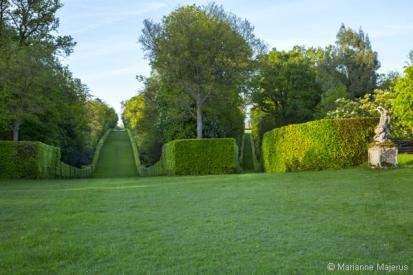
St. Paul’s Walden Bury from the lawn to the goose foot. |
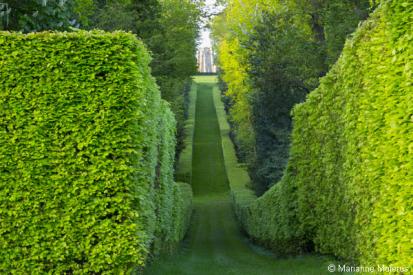
St. Paul’s Walden Bury avenue using the parish church |
The allées were originally hedged with hornbeam, but in the 1930s Sir David Bowes Lyon, a president of the Royal Horticultural Society, replaced them with beech, giving the garden a much more pleasing seasonal interest—lime green in spring, russet in autumn. The right-hand allée leads the eye to the distant sight of the spire of the parish church, here used as an eye-catcher. Another of the avenues leads to an octagonal, neoclassical building erected in 1735 and known as the Organ House. (The roof is a later restoration by Jellicoe.)
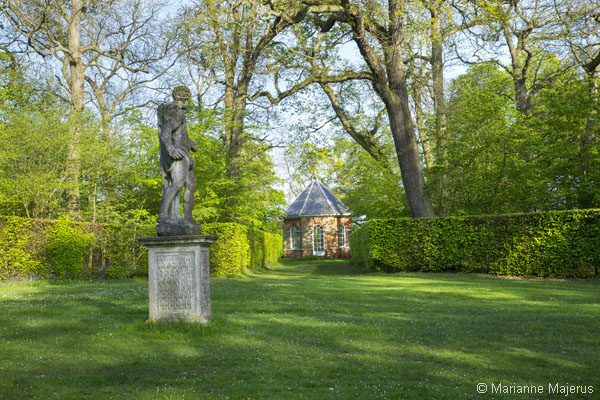
St. Paul’s Walden Bury Organ House.
The quarters between the avenues are planted with graduated and various woodland trees and bisected by transverse avenues leading to a number of concealed garden rooms, notably the “Garden of the Running Footman,” which retains a splendid early eighteenth-century feel, having been subtly restored by Sir Geoffrey Jellicoe in the 1930s. On the right-hand side of this area of avenues lies a small Brownian pond overlooked by a neoclassical temple, which was actually designed by William Chambers (probably around 1760) for Danson Park, Kent, and brought to the garden in 1961. Having been carefully tended and maintained by the same family for nearly three hundred years, St. Paul’s thus presents to today’s visitor the opportunity to experience an extraordinarily authentic wilderness garden of the kind with which Austen and her readers would have been familiar.
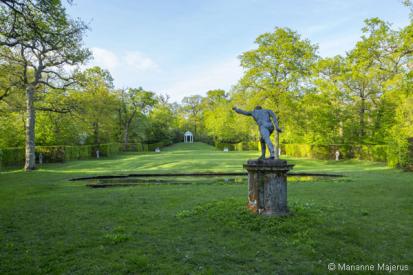
St. Paul’s Walden Bury temple and running footman. |
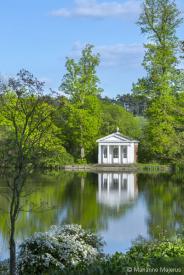
St. Paul’s Walden Bury |
4. Hackwood and Herriards: Probable models for Sotherton in Mansfield Park
Jane Austen almost certainly knew two wilderness gardens just to the south of Basingstoke, and these probably served as models for the Sotherton wilderness in Mansfield Park. The most important of these was Hackwood Park, the seat of Lord Bolton, with whom the Austens were on sociable terms (see Austen, Letters 1-2 December 1798, 8-9 January 1799, 21-23 January 1799, 1 November 1800). Bolton was, nominally, a Powlett (also spelled Paulet), hereditary Marquesses of Winchester and famously loyal supporters of the Tudor monarchy. Before the Civil War the Powletts’ main seat was at Basing House, which protected the route from London to the West Country and which the fifth Marquis defended against the Parliamentarians through the longest siege of the Civil War (27 months), finally yielding to Cromwell in October 1645. The Powletts were sent to the Tower, and Basing was raised to the ground.
Following the Restoration, from 1662 the Powletts developed their estate at Hackwood, an Elizabethan hunting lodge, which they had by 1652 converted into a “Capital Mansion House” standing in a park of 418 acres with “buildings, yards, courtes, courtillages and gardens” (title deed, 12 July 1652, qtd. in Atkin 3). In the early 1680s this house was enlarged again by Charles Powlett, the sixth Marquis, first Duke of Bolton, who probably engaged William Talman to design a neoclassical building comprising a central Trianon-like house linked to two service pavilions by open colonnades (Haslam 58). Charles Powlett was a man of great substance and one of the most important courtiers of his time (Hitchings 30). His work was continued by the second Duke (also Charles) from 1699, then by the third Duke from 1722 (also a Charles [1685-1754] and coincidentally born at Chawton House, which was rented while Hackwood was being rebuilt). The third Duke’s historical fame derives from his having funded Gay’s The Beggar’s Opera in 1728 and fallen for the original Polly Peachum, the lovely Lavinia Fenton, with whom, since he was already married, he eloped to the Continent. Not until his wife’s eventual demise in 1751 was Lavinia able to live at Hackwood. The most important improvements to the grounds were undertaken during the first years of the third Duke’s stewardship (c. 1725-1730) when Charles Bridgeman was called in to arrange the 80 acres of woodland into an enormous array of walks, basins, canals, radiating avenues, and ramparts. At this time it became one of the most famous gardens in the country. A number of splendid garden buildings were also commissioned from James Gibbs, notably the “Menagerie,” “Music Pavilion,” and “Rotunda Temple,” illustrated in his Book of Architecture (1728), to which the Duke subscribed.
On the death of the sixth Duke in 1794, Hackwood passed to the illegitimate daughter of the fifth Duke, Jean Mary Brown Powlett, who married Thomas Orde in 1795. Orde then assumed the name Powlett and was created Baron Bolton in 1797. Baron Bolton set about revising the house, bringing in Lewis William Wyatt, a nephew of the famous James Wyatt, as architect (1805-1807). Baron Bolton also set about bringing order to the grounds. A contemporary guidebook described these works as breaking the avenues “into walks and glades” and admitting “several distant views” while “the lower parts of the wood are in a state of wild and luxuriant nature, with coppice plants and shrubs, sheltered beneath lofty timber trees” (Britton and Brayley 273). The reforms carried out at this time appear to have been sympathetic to the existent structure and definitely did not involve either landscaping à la Brown or a Reptonization. Baron Bolton was followed by his son William, who succeeded to the estate and baronetage on 30 July 1807 at the age of twenty-four and therefore would have been a suitable model for Mansfield Park’s Mr. Rushworth. On 8 May 1810 Bolton married an appropriately named Maria, the eldest daughter of Guy, Baron Dorchester (Atkin 8-9). Of particular importance to Austen scholars is that in their 1805 book Britton and Brayley recorded that “the pleasure grounds . . . had been originally arranged in the old style, by terraces, flights of steps, with pedestals and statues, leading to a great reservoir of water, and terminated by angular ramparts and bastions, &c., [and] the views from the house were also intercepted by high yew-tree hedges, skirting long and formal avenues” (272-73). It therefore seems that the formal elements of the garden were still evident, and this hypothesis is supported by Marc Schoellen’s 1991 description of the gardens, which also records that the pleasure grounds were separated from the deer park by a ha-ha comprising a vertical brick wall and facing earth slope with a sunken fence at the bottom (1, 43).
Given the potential relevance of these grounds to our reading of Mansfield Park, more information may be appreciated. As can be seen in Bridgeman’s plans for the garden (Willis plates 200, 201a, 201b), the pleasure grounds were laid out on the eastern side of the house in the form of a kite.
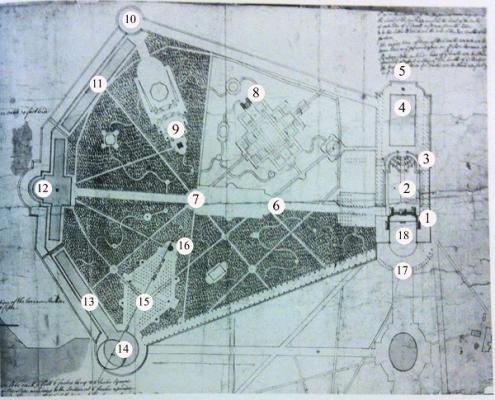
Plan of Hackwood pleasure grounds (c. 1725-30). ©Bodleian Library.
They were divided by two major axial avenues, one north-south (later called the “Twelve o’clock Avenue”) and a “Great Walk” running east-west (leg. 6), bounded by stately limes, and terminating in a temple overlooking a pool (leg. 12). These avenues crossed at a central “rond point” (leg. 7). Three of the quarters so formed, each comprising about 20 acres, were ornamented with a central feature: one had a four-acre amphitheater with five scarped terraces (leg. 15); another had a Music Pavilion and French parterre (leg. 9); and another had, “on a still more princely scale, . . . a number of shaped pieces of water, most notably a chain of canals and basins bounded by avenues and terraces” (Haslam 61; leg. 8). Two lesser avenues, the Brickbat Walk (SW-NE) and the Cockpit Walk (SE-NW), completed the basic diagram. Between these avenues were many sinuous walks of the kind proposed by Batty Langley in his revisions to Wrest Park, and some straight diagonal avenues. Taken together, these features furnished visitors with surprise and pleasure as they sought out the various cabinets de verdure, some of which contained sumptuous ornamental buildings, such as a Menagerie House (leg. 8) containing water fowl and overlooking a pool (which still survive), the Music Pavilion intended for Lavinia’s vocal exercises, and the Rotunda Temple (leg. 16), all designed by James Gibbs and illustrated in his Book of Architecture (plates 72-74).
The whole garden was surrounded by raised terraces above a ha-ha and furnished along the eastern margins with military-style bastions, which granted points of view across the deer park. Such features were common at this time, for example having been used by Bridgeman at Stowe. At the eastern end, the bastions were visually reinforced by an arrangement of three large ponds or canals (leg. 11-14), which were to be supplied by a waterwheel at Loddon near old Basing.
While Hackwood would have certainly furnished Jane Austen with many ideas for Sotherton, it evidently lacked the particular threat of Reptonization. However, a second house with a formal garden, Herriards, adjacent to Hackwood, fulfilled this lack. The neighboring 470 hectare estate of Herriard House had belonged to the Powlet family until the seventeenth century, when it passed with Lucy Powlet, the daughter of Sir Richard Powlet, on her marriage to Sir Thomas Jervoise (1587-1654). In the early seventeenth century it was linked to Hackwood by a grand avenue of silver fir trees. Sir Thomas was an ardent Puritan and supporter of the Parliamentary cause, so relations with his Powlett kin at Hackwood can scarcely have been cordial. In Austen’s time, and indeed to this day, Herriards belonged to the Jervoise family. They had had a new house designed by John James around 1700 and formal grounds laid out by George London between 1699 and 1708. In 1793 George Jervoise commissioned Humphry Repton to produce a Red Book, and Repton’s ideas were implemented between 1794 and 1797 and further developed by John Armstrong in 1799 (Carter 153).
The resonances and echoes between these histories and the representation of Sotherton will have been noticed by informed readers. The Elizabethan origins of both houses; the existence of two extensive formal woodland gardens of the wilderness type, both dating from the early eighteenth century, and in the case of Hackwood being surrounded by raised terraces and ha-has; the conversion Herriards to the modern style in the 1790s by bringing in Mr. Repton; the passing of Hackwood in 1807 to the young William Powlett, aged twenty-four: this configuration of events is so close to Austen’s novel as to suggest that this matrix is one she has refashioned to her imaginative purpose. Indeed, since the Powlett family was famous for nearly bankrupting itself when hosting Elizabeth I and her court in 1560 as well as for thirteen days in October 1601 and for its costly defense of Basing in the civil war, and since the fifth Marquis was known as the “Loyalty Marquis” (Schoellen 17), Austen almost seems to be pointing to this resemblance when she writes of the Rushworths’ “rise and grandeur, regal visits and loyal efforts” (85). Mr. Rushworth is clearly not Mr. Charles Powlett, nor was his wife of the same (relatively low) social status as Maria Bertram, so there is no direct mapping, but it seems very probable that there is a certain imaginative remodelling.
5. The development of shrubberies
The OED’s first recorded use of the word “shrubbery” is in a letter written by Lady Luxborough to the poet and garden-maker William Shenstone in October 1748. About this time shrubberies emerge in two separate and related ways. First, the fashion for tall, clipped hornbeam hedges demarcating the edges of wilderness allées begins to be undermined by the desire to vary the visual effect, sometimes by planting small trees or ornamental shrubs within the line of the hedge. Second, the principle of graduated planting inside the quarters by height, mentioned above, encourages reduction in hedge heights. Together these tendencies lead to the margins of avenues becoming more ornamental and naturalistic. At the same time, the importation of flowering shrubs, particularly through the assiduous trade of John Bartram in Pennsylvania with Peter Collinson in London, encourages exotic display planting. According to Mark Laird, we find Capability Brown, even in his supposedly nude designs, assigning parts of the pleasure grounds to flower gardens and shrubberies where the owner can display his taste and wealth (16-30).
Shrubbery then becomes a very loose term: sometimes designating just a collection of shrubs; sometimes all ornamental planting, whether woody or herbaceous; at other times designating a display border, either entirely woody or mixed with herbaceous flowers and bulbs; and at still others paths weaving through an extensive planting of ornamental shrubs, possibly to obscure the bounds of the property (Mawe and Abercrombie; Abercrombie 337-38; Laird 12). In Austen’s usage we observe many of these types. The Chawton “Shrubberry Border” referred to in Austen’s letter of 29 May 1811 and stocked with “Pinks & Sweet Williams, in addition to the Columbines . . . [and] Syringas,” seems very like a modern flower-bed backed with flowering shrubs. In Lady Susan, on the other hand, the shrubbery is something much more like a wilderness (whether old and formal, or softened by shrubs) since Lady Susan and Reginald are able to “pace the shrubbery for hours together” (268).
In Sense and Sensibility, the pleasure grounds at Cleveland include an “open shrubbery” that we should now be able to understand more precisely:
It had no park, but the pleasure-grounds were tolerably extensive; and like every other place of the same degree of importance, it had its open shrubbery, and closer wood walk, a road of smooth gravel winding round a plantation, led to the front, the lawn was dotted over with timber, the house itself was under the guardianship of the fir, the mountain-ash, and the acacia, and a thick screen of them altogether, interspersed with tall Lombardy poplars, shut out the offices. (302)
The “open shrubbery,” later described as “winding,” and the “closer wood walk, a road of smooth gravel winding round a plantation,” may very well be remnants of a wilderness. In the next paragraph, Marianne follows a route from the “winding shrubbery” to a Grecian temple on an eminence that gives a splendid view. This sequence is exactly the kind we find in very many wilderness gardens of the early eighteenth century. Marianne
quitted [the house] . . . , stealing away through the winding shrubberies, now just beginning to be in beauty, to gain a distant eminence; where, from its Grecian temple, her eye, wandering over a wide tract of country to the south-east, could fondly rest on the farthest ridge of hills in the horizon, and fancy that from their summits Combe Magna might be seen. (302-03)
The topography is very like what we will see in Mansfield Park, but this shrubbery is presumably floriferous, since it is just beginning to be “in beauty,” although it might also be considered beautiful because it is now coming into leaf. We cannot tell.
A little later Marianne, characteristically, uses the shrubbery to catch a potentially fatal cold:
Two delightful twilight walks on the third and fourth evenings of her being there, not merely on the dry gravel of the shrubbery, but all over the grounds, and especially in the most distant parts of them, where there was something more of wildness than in the rest, where the trees were the oldest, and the grass was the longest and wettest, had—assisted by the still greater imprudence of sitting in her wet shoes and stockings—given Marianne a cold so violent, as, though for a day or two trifled with or denied, would force itself by increasing ailments, on the concern of every body, and the notice of herself. (305-06)
Evidently the wildness and oldness of various parts of this shrubbery imply that it was once a formal wilderness which has now been allowed to grow “shrubby.” It might be suggested that at this stage Austen has not developed a particular understanding of the history of shrubbery and is merely using it as a social space convenient to her narrative. Later, in Mansfield Park, she is much more deliberate.
In Pride and Prejudice the shrubbery at Netherfield appears in a similar light. In chapter 10, Miss Bingley walks in the shrubbery with Mr. Darcy and teases him about his evident attraction to Elizabeth:
At that moment they were met from another walk, by Mrs. Hurst and Elizabeth herself.
“I did not know that you intended to walk,” said Miss Bingley, in some confusion, lest they had been overheard.
“You used us abominably ill,” answered Mrs. Hurst, “in running away without telling us that you were coming out.”
Then taking the disengaged arm of Mr. Darcy, she left Elizabeth to walk by herself. The path just admitted three. Mr. Darcy felt their rudeness and immediately said,
This walk is not wide enough for our party. We had better go into the avenue.”
But Elizabeth, who had not the least inclination to remain with them, laughingly answered,
“No, no; stay where you are.—You are charmingly group’d, and appear to uncommon advantage. The picturesque would be spoilt by admitting a fourth. Good bye.” (53)
The contrast between the width of the path they are on and the greater width of the avenue implies that this shrubbery either is or was once a formal wilderness, and probably is still organized by wide, straight avenues cut across with narrower, sinuous paths.
Also in Pride and Prejudice, there is the small wilderness at Longbourn, which grants Lady Catherine de Bourgh another opportunity to sneer at the Bennets when she says, “‘Miss Bennet, there seemed to be a prettyish kind of a little wilderness on one side of your lawn. I should be glad to take a turn in it, if you will favour me with your company’” (352). Since wildernesses are rarely less than several acres, Lady Catherine’s oxymoron wins out in the matter of condescending grandeur. Possibly she is trying to belittle a shrubbery by false comparison; whatever her gambit, the indelicacy of her sneer and the clumsy illiteracy of her phrasing give the trumps to Elizabeth.
In Mansfield Park, just after Mr. Rushworth has spoken about bringing Repton in to reform Sotherton, Lady Bertram proposes he should have “‘a very pretty shrubbery’” for “‘One likes to get out into a shrubbery in fine weather’” (55). Mansfield’s shrubbery is evidently frequented by Lady Bertram; it is also the place to which Fanny can be sent by Sir Thomas to reflect in solitude on the folly of her refusing Henry Crawford’s proposal of marriage (322). The Grants, too, have a shrubbery at their parsonage, which has evidently been planted recently and is typical of the vogue for using loose arrangements of shrubs to conceal or soften the bounds of relatively modest grounds. Fanny observes to Mary Crawford,
Every time I come into this shrubbery I am more struck with its growth and beauty. Three years ago, this was nothing but a rough hedgerow along the upper side of the field, never thought of as any thing, or capable of becoming any thing; and now it is converted into a walk, and it would be difficult to say whether most valuable as a convenience or an ornament; and perhaps in another three years we may be forgetting—almost forgetting what it was before. How wonderful, how very wonderful the operations of time, and the changes of the human mind! (208)
For her part, Mary Crawford observes, “‘till I came to Mansfield, I had not imagined a country parson ever aspired to a shrubbery or any thing of the kind’” (209). Again, perhaps, like Lady Catherine, Mary has something bigger in mind than the modest bit of marginal planting implied by a rough hedgerow that has increased in scale.
By the time of Emma, the shrubbery at Hartfield has become the kind of mixed belt of shrubs and trees that today grants some privacy to larger houses in the countryside and small towns. For Mr. Woodhouse it constitutes a protective frontier beyond which he fears to tread, while for Emma it constitutes a place of natural recreation, and, indeed, a place where, like Fanny, she will experience a lover’s metamorphosis:
The weather continued much the same all the following morning; and the same loneliness, and the same melancholy, seemed to reign at Hartfield—but in the afternoon it cleared; the wind changed into a softer quarter; the clouds were carried off; the sun appeared; it was summer again. With all the eagerness which such a transition gives, Emma resolved to be out of doors as soon as possible. Never had the exquisite sight, smell, sensation of nature, tranquil, warm, and brilliant after a storm, been more attractive to her. She longed for the serenity they might gradually introduce; and on Mr. Perry’s coming in soon after dinner, with a disengaged hour to give her father, she lost no time in hurrying into the shrubbery.—There, with spirits freshened, and thoughts a little relieved, she had taken a few turns, when she saw Mr. Knightley passing through the garden door, and coming towards her.—It was the first intimation of his being returned from London. (424)
In conclusion, then, it appears that shrubbery for Jane Austen is as vague a term as it was to many of her contemporaries, even when in the detail of her description we can discern that she probably has in mind real places that have evolved from wildernesses that have been deliberately relaxed, or just let go, in recent decades. These social and ornamental spaces are neutral in regards to the narrative, which is not the case—I am about to argue—in her representation of the wilderness in Mansfield Park.
6. Reading the wilderness at Sotherton in Mansfield Park
Our consideration of Austen’s references to shrubberies and wildernesses should sharpen our understanding of the major wilderness scene in chapters 9 and 10 of Mansfield Park. Readers will recall that a large house party travels from Mansfield to Sotherton to view the future home of Maria Bertram, who is engaged to Mr. Rushworth. Having visited the interior of the Elizabethan Sotherton house, notably the chapel, which was “‘fitted up . . . in James the Second’s time’” (86), the party explores the gardens, of which the wilderness is offered as something of a rarity: “‘I believe the wilderness will be new to all the party,’” says Mrs. Rushworth (90). They take an overview of the pleasure grounds:
The lawn, bounded on each side by a high wall, contained beyond the first planted area a bowling-green, and beyond the bowling-green a long terrace walk, backed by iron palissades, and commanding a view over them into the tops of the trees of the wilderness immediately adjoining. (90)5
Crossing the lawn, the party resolves into three groups of three: the first is composed of Mr. Crawford, Miss Bertram, and Mr. Rushworth and the second of Edmund, Fanny, and Miss Crawford, who walk ahead to the terrace; slowly bringing up the rear are members of the older generation, Mrs. Rushworth and Mrs. Norris, with whom Julia finds herself lumbered. Having walked up and down the terrace, Miss Crawford remarks, “‘This is insufferably hot. . . . Shall any of us object to being comfortable?’” and opens a door giving onto a “considerable flight of steps,” which leads down into the wilderness:
The door, however, proved not to be locked, and they were all agreed in turning joyfully through it, and leaving the unmitigated glare of day behind. A considerable flight of steps landed them in the wilderness, which was a planted wood of about two acres, and though chiefly of larch and laurel, and beech cut down, and though laid out with too much regularity, was darkness and shade, and natural beauty, compared with the bowling-green and the terrace. They all felt the refreshment of it, and for some time could only walk and admire. At length, after a short pause, Miss Crawford began with, “So you are to be a clergyman, Mr. Bertram. This is rather a surprise to me.” (91)
That this wilderness comprises two acres planted chiefly with “larch and laurel, and beech cut down” indicates that it is of the type we have been considering, consisting of walks with trimmed beech hedges at the sides and providing shade on a hot summer’s day. As the party walks in the wilderness, Fanny is a silent witness as Mary teases Edmund about his vocation to be a clergyman, to which he replies that it is the clergy’s duty to teach and exemplify the best principles, in effect to be the moral guardians of the nation: “‘as the clergy are, or are not what they ought to be, so are the rest of the nation’” (93). Given what we now know about how wilderness gardens were conceived in the seventeenth century—the period in which Sotherton was laid out—such a discussion of religious duty gains considerable poignancy from the context.
As Edmund and Mary talk, they walk along serpentine paths, until eventually Mary disputes the distance travelled, pretending that the distance has been great, reckoning the distance with “feminine lawlessness”; Edmund assures her she exaggerates. They thus epitomize some of the functions of a wilderness, to enable pleasing recreation and conversation and to bewilder our regular sense of time and space. Edmund, the male rationalist, observes, “‘But if you remember, before we left that first great path, we saw directly to the end of it. We looked down the whole vista, and saw it closed by iron gates, and it could not have been more than a furlong in length’” (95). Edmund has a very sure sense of the bounds of the wilderness: he will not lose his physical or moral compass. Mary protests they have walked at least a mile, but Edmund checks the time elapsed on his watch and advises her that they have been walking “‘exactly a quarter of an hour.’” To this Mary replies, “‘Oh! do not attack me with your watch. A watch is always too fast or too slow. I cannot be dictated to by a watch’” (95).
When Mary, Edmund, and Fanny come out of the wilderness, they find themselves looking over a ha-ha into the park beyond. They sit on a bench while Mary and Edmund continue to flirt with each other through disputing distances, Mary refusing to apply mathematical common-sense, content blindly to assume that her subjective understanding is perfectly adequate, when it clearly is not. Finally she and Edmund decide to abandon Fanny on the bench and “endeavour to determine the dimensions of the wood by walking a little more about it” (96). The symbolism is delightful: they play at testing the limits of the physical space as they test out each other’s moral limits; as we will discover in the last chapters of the novel, Mary’s disregard for regularity and her inability to understand the relation of elapsed time to distance travelled will allow her to condone Maria’s adultery, provided it can be kept quiet. Her disregard for moral regularity and principle will cause Edmund to turn to Fanny, leaving Mary to the life of a wealthy, discontented spinster, frustrated by her inability to find any man as attractive as Edmund.
Given this narrative outcome, we realize that while the wilderness garden bewilders with its serpentine (i.e., tempting and satanic) paths and provides many opportunities for shady invisibility and sexual misconduct, Edmund’s behavior shows that it can nonetheless be governed by the kind of moral rectitude Christ himself discovered in his own days in the wilderness. The serpentine can be controlled by being watchful. Baroque fascination and flirtation can be held tight within a linear, rational framework. Insofar as Sotherton is an example of the customary order, now threatened with Reptonian improvement, the formal structures of the wilderness garden may be seen as exemplary.6
According to the narrator, “[a] quarter of an hour, twenty minutes” after Edmund and Mary Crawford have walked off to test the bounds—notice how the narrator is aligned with Edmund’s clock-based understanding—Miss Maria Bertram, Mr. Rushworth, and Mr. Crawford arrive to share the bench and the view. Miss Bertram then observes an iron gate giving onto the park beyond the ha-ha and declares her wish to pass through it, ostensibly so that they can have a better prospect of the effects of proposed improvements to the landscape around the house. Henry Crawford takes Maria’s hint, pointing to the distant knoll, “which would give them exactly the requisite command of the house. Go then they must to that knoll, and through that gate; but the gate was locked” (98). Mr. Rushworth is dispatched for the key, and Maria and Henry quickly slip through a gap at the side of the gate so they can enjoy each other’s company in the freedom of the park.
Ironically, as we discover at the end of the novel, neither Henry nor Maria will understand the prospects for improvement: they do not have sufficient understanding of (garden) history, taken up as they are with short-term personal gratifications. We may also notice here that Henry and Maria’s flirtation is frustrated inside the apparently private and hidden spaces of the wilderness but given full scope in the open parkland and on the distant knoll. This might be merely a pragmatic effect: one can be hidden in a wilderness but one can also be surprised. Out in parkland, one can be more alone. But my personal hunch is that Austen eschews the obvious opportunity of misconduct in a wilderness (as at St. Paul’s Walden Bury) because she prefers us to see the wilderness as a space of temptation bounded by formality, as the example of Mary and Edmund shows. So Henry and Maria develop their illicit relationship moving from the space of temptation, out across the park to the knoll, which is covered in a grove of oaks. In many eighteenth-century gardens such a grove or mount intended a classical reference to the oak groves which Greeks (and Druids) saw as the abode of pagan gods and lusty spirits. As for the parkland, while originally parks were created for hunting deer, by 1813 parkland was associated with the modernizers. It is therefore appropriate that the misconduct of Henry and Maria takes place in the grove and the park, where it can be associated with both pre-Christian paganism and the unbounded freedoms of modernity. This argument may seem to some readers a little stretched, but, once the history of the wilderness garden is understood, both in its religious symbolism and as an emblem of the ancient regime in revolutionary times, it does seem likely that Austen intends readers here to read the context as informing the moral scene. Austen’s use of these garden spaces is aesthetically rather brilliant: it provides a rich counterpoint to her narrative and shows a fine appreciation of garden history.
NOTES
This paper was first presented in a symposium entitled “Experiencing the Georgian Garden” at Chawton House Library in February 2015. My thanks to Stephen Bending and to Gillian Dow for organizing this interesting occasion. This paper is indebted to two current landscape architects and historians of landscape gardens, Marc Schoellen and George Carter, and to John Watkins, head of gardens at English Heritage, for their friendship, advice, and inspiration over many years. I am also grateful to Sir Simon and Lady Caroline Bowes-Lyon for their hospitality at St. Paul’s Walden Bury, and especially for allowing us to host a symposium on Pride and Prejudice at St. Paul’s in 2013.
1I am of course not alone. In recent years the wilderness gardens at Ham House and Wrest Park have been restored, by the National Trust and English Heritage. Restoration is now underway at Chevening in Kent under the supervision of George Carter, and the team at Chawton House Library is considering how best to restore the small wilderness there, which Jane Austen knew well.
2The word derives from Renaissance gardens, which were often divided into four rectangular plots of equal size, with paths around the sides leading to a central fountain or statue. Later, the word is used more like the word “quartier” in modern French, designating a neighborhood, and allowing for the fact that there can be more than four.
3For commentary on this garden, see O’Halloran and Woudstra.
4Chevening is currently being restored under the guidance of the garden historian and landscape architect George Carter.
5Notice here how this description resembles the way in which at Wilton, and perhaps at Hackwood, raised terraces overlooked the wilderness.
6Since my purpose in this essay is to set out the history of garden forms, the allotted space requires me to confine my critical commentary; I simply recommend Inger Brodey’s 2014 essay in which the problematic of moral progress and question of discipline and self-discipline is brilliantly and succinctly set out.
